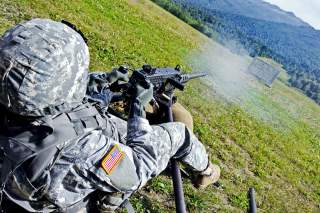U.S. Army Networks 50-cal Sights to Helmet Display
Making America's big guns even more powerful.
Using a wireless link, gun-mounted thermal sights send a targeting reticle from the gun to a soldier head-worn display, allowing soldiers to hit targets without needing to physically “look” through the gun-sights themselves in a certain physical position.
The U.S. Army will soon begin to produce new high-tech, crew-served thermal weapons sights able to automatically adjust range, see through adverse weather, detect targets with a lightweight laser range finder and use a wireless targeting link between weapons and a soldier-worn helmet display, service officials said.
Designed for the M2 .50-cal, M240 machine gun and Mk 19 grenade launcher, the system brings higher-resolution thermal imaging technology and increases field of view, developers explained.
“This is the first time the soldier will have a system which combines a true day and night capability with a laser range finder to adjust for the ballistics of the various ammunition types for the crew served weapons,” an Army official told Scout Warrior.
BAE Systems was recently awarded an Army contract to develop the technology, called Family of Weapons Sights – Crew Served (FWS-CS), in a deal worth up to $384 million.
Using a wireless link, gun-mounted thermal sights send a targeting reticle from the gun to a soldier head-worn display, allowing soldiers to hit targets without needing to physically “look” through the gun-sights themselves in a certain physical position -- such as crouching, lying down or standing exposed in a vehicle-mounted gun-turret, the Army official explained.
A wireless helmet mounted display is designed to provide a more natural firing position as well as allow soldiers to remain more protected, a BAE systems statement said. Crew-served weapons, such as the .50-cal machine gun, are often used to “blanket” enemy areas so that troops can maneuver while under attack or deliver suppressive fire.
A wireless link allowing soldiers to remain in a standing position or different configuration than what is otherwise needed to look through the sights naturally lowers the risk of exposing soldiers to enemy fire.
BAE Systems’ FWS-CS system is also engineered to improve targeting speed and precision. It uses a 12-micron sensor technology to provide soldiers with greater clarity and range, developers said.
“FWS-CS also, for the first time, incorporates a high-resolution day camera and laser range finder into the weapon sight, allowing the user to engage targets with a range correct reticle,” John Koltookian, technical director at BAE Systems, told Scout Warrior.
With an initial development order of $10.5 million, work will be performed at the company’s facilities in Hudson, New Hampshire and Austin, Texas.
This crew-served weapons technology is engineered to function alongside a similar Army program called Family of Weapons Sights – Individual (FWS-I); in similar fashion to the FWS-CS, this system uses a wireless link to connect thermal sights on an M4 rifle with an individual soldier’s night-vision goggles display.
A key advantage of this technology is, by design, to allow soldiers to target and attack enemies without having to “shoulder” the weapon and bring it up to their face.
FWS-I is already in Low-Rate-Initial Production and slated to be operational by 2018, service officials said.
Kris Osborn became the Managing Editor of Scout Warrior in August of 2015. His role with Scout.com includes managing content on the Scout Warrior site and generating independently sourced original material. Scout Warrior is aimed at providing engaging, substantial military-specific content covering a range of key areas such as weapons, emerging or next-generation technologies and issues of relevance to the military. Just prior to coming to Scout Warrior, Osborn served as an Associate Editor at the Military.com. Osborn previously served at the Pentagon as a Highly Qualified Expert with the Office of the Assistant Secretary of the Army - Acquisition, Logistics & Technology. Osborn has also worked as an anchor and on-air military specialist at CNN and CNN Headline News. This story originally appeared in Scout Warrior.
Image Credit: U.S. Army Flickr.

